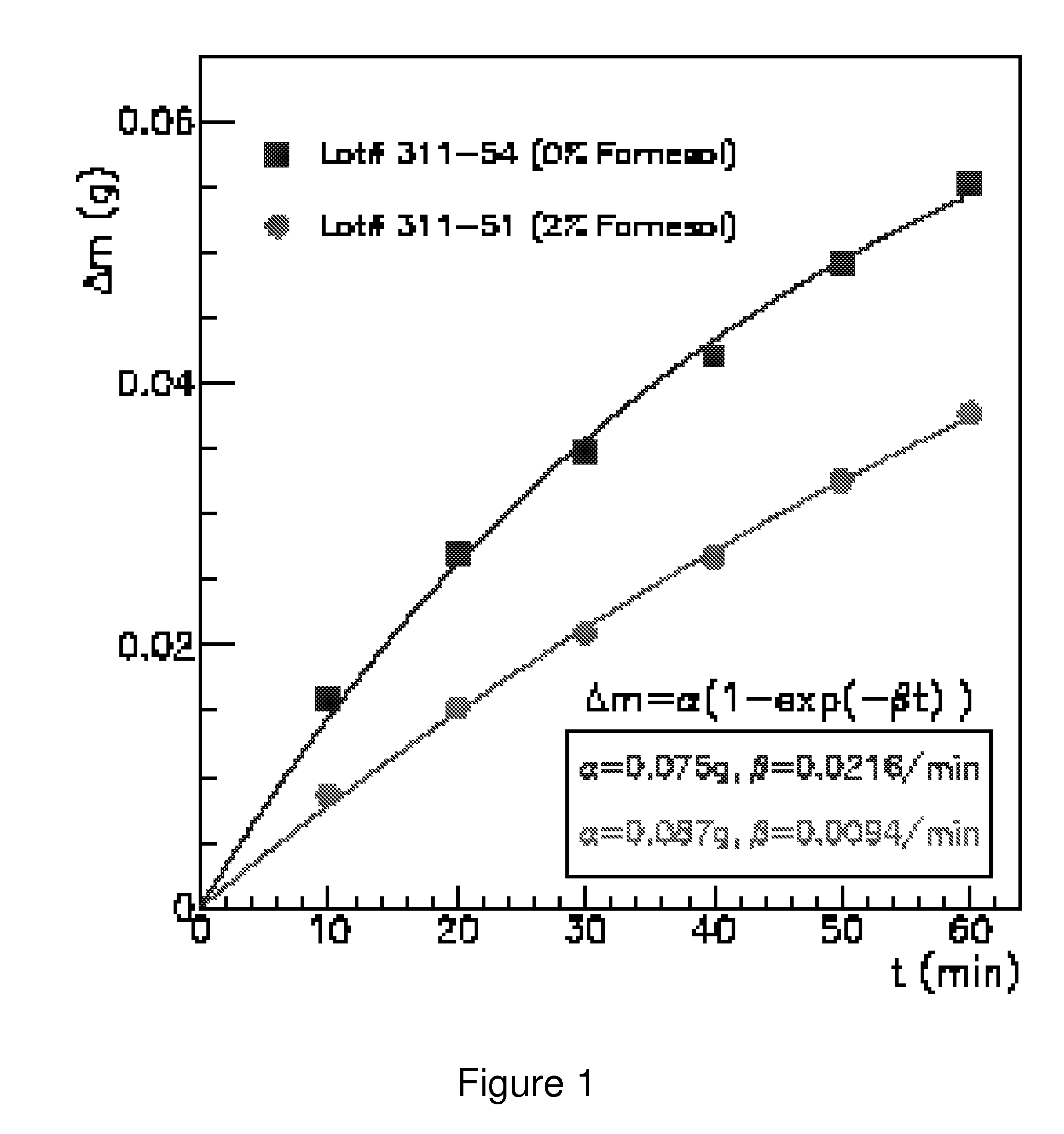Odor suppression of volatile organic analgesic compounds and method of use
- Summary
- Abstract
- Description
- Claims
- Application Information
AI Technical Summary
Benefits of technology
Problems solved by technology
Method used
Image
Examples
example 1
[0023]A simple formulation with 0.75% propylene glycol, 8.13% of Novasome (a trademark of IGI Laboratories, Inc.) encapsulated menthol (which contains 1.3% of the total amount of 1-Menthol), 8.13% farnesol, 4% Novemer EC-2 polymer (a sodium acrylates / beheneth-25 methacrylate crosspolymer and hydrogenated polydecene and lauryl glucoside combination thickener, stabilizer and emulsifier sold by Lubrizol Corp.), 0.3% SymSitive 1609, and 78.7% water. This embodiment results in a thick, stable, non-irritating cream with no readily discernable menthol odor even when applied to the skin.
[0024]It will be noted in Example 1 that the actual amount of menthol is only 1.3%, since only about 15-17% of the Novasome encapsulated menthol is actually menthol, and the remaining 83-85% is the encapsulation material. Thus, there is only 1.3% menthol by weight, and 8.13% farnesol. This is a moderate to high level of farnesol, and it can be extrapolated that if there was actually 16% menthol instead of 1....
example 2
[0026]A more complex formulation that results in a cream having significantly reduced menthol and camphor odor can be created as described below with the following ingredients:[0027]Emulsifiers: Glyceryl Stearate 4%,[0028]Cetyl Alcohol 2%,[0029]Stearic Acid 2%,[0030]Steareth-21 6%[0031]Non Volatile Solvents: Propanediol 10%[0032]Skin Protectant Allantoin 0.1%[0033]Thickener: Carbopol Ultrez-21 0.5%[0034]Skin Moisturizer Aloe Barbadensis Leaf Juice: 0.6%[0035]Actives: Encapsulated Menthol: 0.5%; Encapsulate Material: NOVASOME from (IGI Labs)[0036]Menthol Racemic 15.5%[0037]Camphor 11%[0038]Anti-Irritation[0039]Ingredient: SymSitive 1609—Pentylene Glycol and 4-t-Butylcyclohexanol: 0.3%[0040]Solvents: Water 37%,[0041]Ethanol 5%[0042]Fragrance: 0.5% (Citron, Peppermint oil, Spearmint oil, grapefruit oil, cucumber Asian Pear) each 0.1%[0043]Farnesol 2%[0044]pH Adjuster: Triethanolamine 0.3%
[0045]This cream is prepared in a series of steps to maximize the odor reducing capability of the f...
example 3
Patch Formulation Example
Polyisobutene B12—15%
Polyisobutene B100—4.5%
Polyethylene Glycol 400—5%
BIO-PSA (Pressure Sensitive Adhesive) 7-4102 Silicone Adhesive (By Dow Corning)—5%
Isopropyl Myristate—25%
Isopropyl Palmitate—25%
Menthol 5%
Camphor 5%
Ethanol 5%
Farnesol 5%
SymSitive 0.5%
[0065]Since the carrier of a patch formulation is a solid dough that is typically applied to a fabric backing, it is difficult to formulate products with the maximum levels of both menthol (16%) and camphor (11%) together with the necessary solvents and deodorizing bactericidal agent.
[0066]The dough recipes of patch formulations vary widely, although the most common are either hydrogels or hydrophobic polymers such as a rubber polymer, an acrylic polymer or a silicon polymer. Since neither menthol nor camphor are significantly soluble in water, the hydrophobic polymers are quite suitable.
PUM
| Property | Measurement | Unit |
|---|---|---|
| Temperature | aaaaa | aaaaa |
| Fraction | aaaaa | aaaaa |
| Fraction | aaaaa | aaaaa |
Abstract
Description
Claims
Application Information
 Login to View More
Login to View More - R&D
- Intellectual Property
- Life Sciences
- Materials
- Tech Scout
- Unparalleled Data Quality
- Higher Quality Content
- 60% Fewer Hallucinations
Browse by: Latest US Patents, China's latest patents, Technical Efficacy Thesaurus, Application Domain, Technology Topic, Popular Technical Reports.
© 2025 PatSnap. All rights reserved.Legal|Privacy policy|Modern Slavery Act Transparency Statement|Sitemap|About US| Contact US: help@patsnap.com


